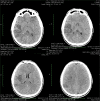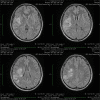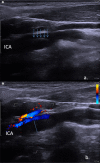Stroke Secondary to Traumatic Carotid Artery Injury - A Case Report
- PMID: 29967897
- PMCID: PMC5953265
- DOI: 10.1515/jccm-2018-0003
Stroke Secondary to Traumatic Carotid Artery Injury - A Case Report
Abstract
Introduction: Lesions of the carotid and vertebral arteries secondary to direct trauma, called blunt cerebrovascular injuries (BCVI) are relatively rare and are markedly different from spontaneous dissections. Ischaemic stroke is a significant complication, with high morbidity and mortality rates. The basis of a diagnosis relies on appropriate, high sensitivity imaging screening.
Case report: We present the case of a 31 years old male patient with polytraumatism secondary to a motor vehicle accident, who was admitted to an orthopaedic clinic for multiple lower extremity fractures. His fractures were treated surgically. He developed in the 3rd day after the admission left sided hemiparesis secondary to ischaemic stroke. The diagnosis of traumatic carotid artery injury (TCAI) was based on duplex ultrasound and angio CT scans. The outcome was favourable despite the severe carotid lesions presenting with occlusion secondary to dissection.
Conclusions: In the majority of BCVI cases there is a variable latent period between the time of injury and the development of stroke. The management of cases is challenging because in the majority of cases there are multiple associated injuries. Although antithrombotics are widely used in the treatment, there is no consensus regarding the type of agent, the optimal dose or treatment duration.
Keywords: blunt cerebrovascular injuries; carotid artery; post-traumatic dissection; stroke; traumatic carotid artery injury.
Conflict of interest statement
Conflict of interest: None to declare.
Figures




Similar articles
-
Clinical and radiographic outcomes following traumatic Grade 3 and 4 carotid artery injuries: a 10-year retrospective analysis from a Level 1 trauma center. The Parkland Carotid and Vertebral Artery Injury Survey.J Neurosurg. 2015 Mar;122(3):610-5. doi: 10.3171/2014.10.JNS14875. Epub 2014 Dec 19. J Neurosurg. 2015. PMID: 25526279
-
Increased detection of blunt carotid and vertebral artery injury after implementation of diagnostic imaging pathway in level 1 trauma centre in Western Australia.Injury. 2017 Sep;48(9):1917-1921. doi: 10.1016/j.injury.2017.06.006. Epub 2017 Jun 13. Injury. 2017. PMID: 28647095
-
Blunt cerebrovascular injuries in severe traumatic brain injury: incidence, risk factors, and evolution.J Neurosurg. 2017 Jul;127(1):16-22. doi: 10.3171/2016.4.JNS152600. Epub 2016 Jul 29. J Neurosurg. 2017. PMID: 27471889
-
Internal carotid artery dissection following blunt head trauma: a pediatric case report and review of the literature.Turk J Pediatr. 2020;62(6):1077-1087. doi: 10.24953/turkjped.2020.06.021. Turk J Pediatr. 2020. PMID: 33372448 Review.
-
Dissection of the internal carotid artery and stroke after mandibular fractures: a case report and review of the literature.J Med Case Rep. 2017 Jun 2;11(1):148. doi: 10.1186/s13256-017-1316-1. J Med Case Rep. 2017. PMID: 28576125 Free PMC article. Review.
Cited by
-
Endovascular treatment of blunt injury of the extracranial internal carotid artery: the prospect and dilemma.Int J Med Sci. 2021 Jan 1;18(4):944-952. doi: 10.7150/ijms.50275. eCollection 2021. Int J Med Sci. 2021. PMID: 33456352 Free PMC article. Review.
-
Blunt cerebrovascular injury of cervical and petrous ICA with stroke: A case study.Trauma Case Rep. 2022 Mar 21;39:100637. doi: 10.1016/j.tcr.2022.100637. eCollection 2022 Jun. Trauma Case Rep. 2022. PMID: 35360003 Free PMC article.
-
Diagnostic and prognostic computed tomography imaging markers in basilar artery occlusion (Review).Exp Ther Med. 2021 Sep;22(3):954. doi: 10.3892/etm.2021.10386. Epub 2021 Jul 6. Exp Ther Med. 2021. PMID: 34335896 Free PMC article. Review.
-
Cerebral infarct secondary to traumatic internal carotid artery dissection.World J Clin Cases. 2020 Oct 26;8(20):4773-4784. doi: 10.12998/wjcc.v8.i20.4773. World J Clin Cases. 2020. PMID: 33195645 Free PMC article.
-
Blunt carotid injury with thrombotic occlusion: Is an intervention always required for best outcome?Trauma Case Rep. 2019 Dec 5;24:100263. doi: 10.1016/j.tcr.2019.100263. eCollection 2019 Dec. Trauma Case Rep. 2019. PMID: 31872027 Free PMC article.
References
-
- Liang T, Tso DK, Chiu RY, Nicolaou S.. Imaging of blunt vascular neck injuries: a clinical perspective. Am J Roentgenol. 2013;201:893–901. - PubMed
LinkOut - more resources
Full Text Sources
